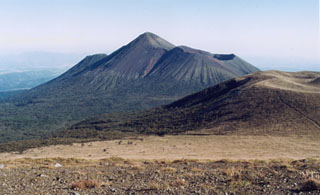Report on Kirishimayama (Japan) — 18 June-24 June 2025
Smithsonian Institution / US Geological Survey
Weekly Volcanic Activity Report, 18 June-24 June 2025
Managing Editor: Sally Sennert.
Please cite this report as:
Global Volcanism Program, 2025. Report on Kirishimayama (Japan) (Sennert, S, ed.). Weekly Volcanic Activity Report, 18 June-24 June 2025. Smithsonian Institution and US Geological Survey.
Kirishimayama
Japan
31.934°N, 130.862°E; summit elev. 1700 m
All times are local (unless otherwise noted)
The Japan Meteorological Agency (JMA) reported that an eruption occurred at Shinmoedake (Shinmoe peak, a stratovolcano of the Kirishimayama volcano group) on 22 June, the first eruption since 27 June 2018. The number of volcanic earthquakes with epicenters directly beneath Shinmoedake had been fluctuating since late October 2024 but began to increase starting around 13 June. Another increase occurred at around 2100 on 21 June, and volcanic tremor increased on 22 June. An eruption detected during 1637-1755 on 22 June produced an ash plume that rose 500 m above the crater rim and drifted E. Ashfall was confirmed in a wide area to the NE that included Takaharu Town, Kobayashi City, Miyazaki City, Kunitomi Town, Saito City, and Shintomi Town in Miyazaki Prefecture. A large amount of ashfall in Hirohara, Takaharu-cho, Miyazaki Prefecture obscured the white lines on the roadway. Sulfur dioxide emissions averaged 4,000 tons per day on 23 June; no emissions were detected on 15 May during the last measurement. On 23 June the Alert Level was raised to 3 (on a 5-level scale) and the public was warned to exercise caution within 3 km from Shinmoedake Crater.
Geological Summary. Kirishimayama is a large group of more than 20 Quaternary volcanoes located north of Kagoshima Bay. The late-Pleistocene to Holocene dominantly andesitic group consists of stratovolcanoes, pyroclastic cones, maars, and underlying shield volcanoes located over an area of 20 x 30 km. The larger stratovolcanoes are scattered throughout the field, with the centrally located Karakunidake being the highest. Onamiike and Miike, the two largest maars, are located SW of Karakunidake and at its far eastern end, respectively. Holocene eruptions have been concentrated along an E-W line of vents from Miike to Ohachi, and at Shinmoedake to the NE. Frequent small-to-moderate explosive eruptions have been recorded since the 8th century.

